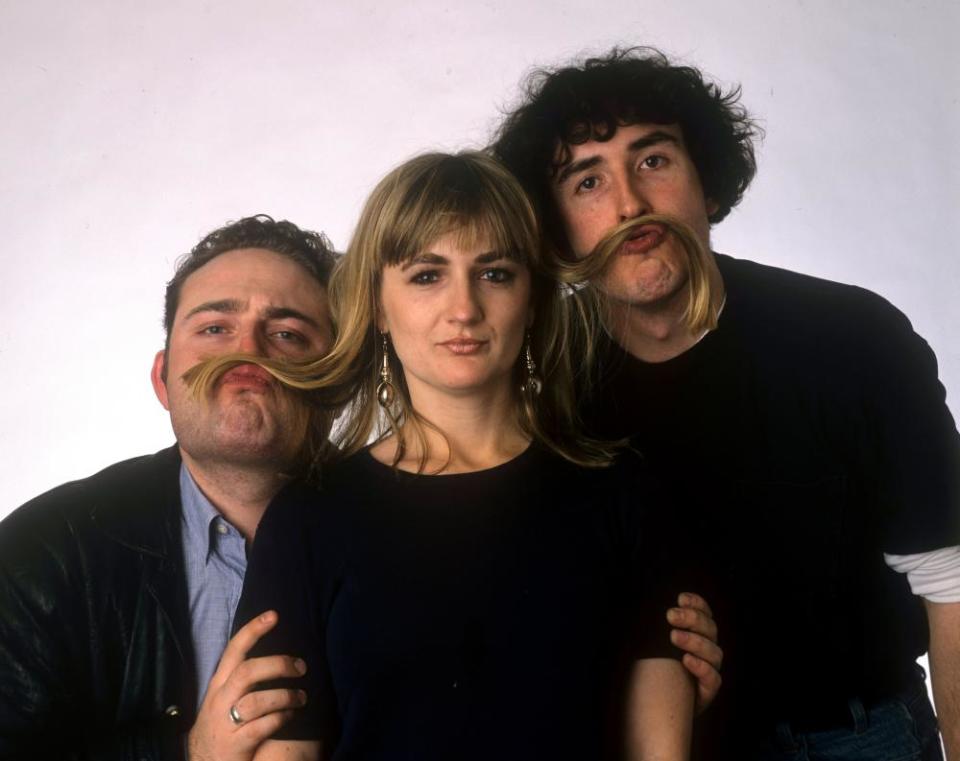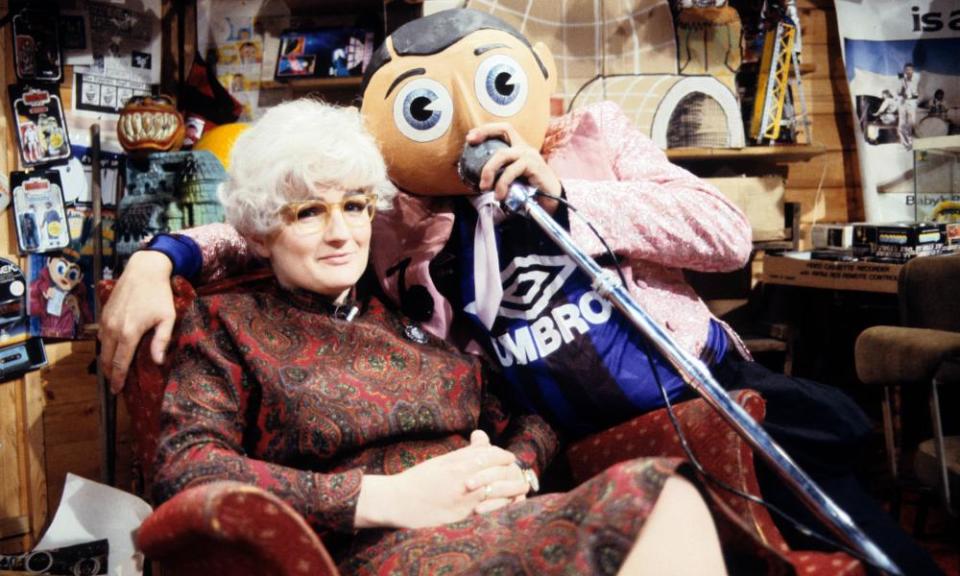Mrs Merton and the naughty nun: Caroline Aherne’s first comedy gigs
In the early 90s, Manchester’s cultural revolution was in full swing. “Everything was thriving,” remembers actor, writer and comedian John Thomson who grew up in Preston before studying drama at Manchester Polytechnic. Beyond the Haçienda, a comedy scene was growing in the city’s pub rooms where Thomson made friends with Wythenshawe local Caroline Aherne. “In Manchester at that time, there were a lot of funny people,” Thomson says. “Caroline was naturally funny.”
Aherne’s comic creation Mrs Merton, the elderly talk-show host treading the line between innocence and insult, had begun making appearances in the late 80s alongside Frank Sidebottom. Aherne was also performing as the Mitzi Goldberg Experience. “She used to wear this awful acrylic, curly wig, and she put on a southern drawl. It was Dolly Parton of sorts,” Thomson recalls. “I think she had a guitar, but she couldn’t play. There were probably no strings.”
Mitzi was soon usurped by cheeky nun Sister Mary Immaculate. Aherne adopted an Irish accent (studied from her parents), full habit and Bible. Instead of verses, it was filled with jokes (“People say to me, ‘Where does the Bible stand on homosexuality?’ Three times in the Bible Jesus said: ‘Get thee behind me Satan.’”)

After meeting through Craig Cash, with whom she created the hit sitcom The Royle Family, Aherne and Thomson got to know each other performing at the Buzz Club in Chorlton. People queued around the block for the club, which was started by John Marshall, known as Agraman the Human Anagram. As host, Marshall offered “groan-worthy standup”, smashing out pun after pun. “It was a great place to cut your teeth if you fancied doing something a bit different,” says Thomson.
Thanks to Manchester-based Granada’s encouragement of local talent, Thomson and Aherne soon moved to TV with regional variety show What’s New? and sketch pilot The Dead Good Show. Then, later, game show Remote Control, and sketch shows The Full Monty and The Fast Show. The pair also performed at universities. There’d be “horrible dressing rooms, stinking of fags, bog seat on the floor”, says Thomson. But they allowed Aherne to indulge a surprising habit: “Caroline always used to carry a massive handbag. We’d be talking about the gig, then she’d go ‘Look at that’, and she’d robbed something! She’d take things like a hammer or a sign for the ladies: ‘I’ll have that to put on my toilet door.’”
Aherne often had “an entourage of close female friends” to ward off the loneliness of gigging alone. She didn’t always enjoy live performance. New material gigs at the Band on the Wall venue were tough – sometimes she’d profess her desire to become a hairdresser instead.

Occasionally, she’d do standup where “she’d just talk about life”. Thomson remembers one anecdote about himself. The punchline? That he, a northern lad, steamed vegetables for his tea. To Aherne, this was hilarious. “Sometimes she’d do gags that didn’t have a payoff – she left a big pause. Because it was Caroline, it worked. The checkout girl on The Fast Show and the teenage girl in the bedroom, they grew from that standup.”
In 1992, Thomson and Steve Coogan won the Perrier award in Edinburgh. The following year, Thomson returned, this time with Aherne and Simon Day. It didn’t go smoothly. Thomson had imagined a variety show, with the trio’s established characters, music and sketches, but Aherne “couldn’t be arsed” and they arrived with a less-than-polished show. Some nights she’d cry and beg to cancel, Thomson says: “The show was called Do You Like Us? A simple one-word review: no!”
Nevertheless, there were quality sketches. In Have a Dance, Thomson was a Peter Dickson-style announcer. “Caroline’s stood stock-still in the middle of the room. I went: ‘This is Julie. Julie’s 52, lives alone, has one cat called Dave and one called Smokey. She loves nothing more than tucking into a box of Dairy Milk while watching Shirley Valentine. Julie! Feel free to have a dance!’” Music would kick in and Aherne suddenly started dancing. Bob Mortimer described it as “absolute class”.
There was also an early version of The Fast Show’s pretentious dance group Thrusk. The trio appeared as The Zeitgeist Theatre Company, wearing moon-shaped masks, dressed in black, attempting contemporary dance moves. “It got a massive laugh,” says Thomson.
In 1994, Dave Perkin opened the Frog and Bucket comedy club in Manchester. It began as a cosy 80-seater, which became Aherne’s “social club”, Perkin says: “She was enjoying the comedy and mentoring comedians like Dave Gorman and Lucy Porter. Caroline was always really supportive.” The Mrs Merton Show had become a TV show at Granada and Aherne’s fame was growing. At the Frog, she’d be “networking with comedians, who then became part of the show”.
She still performed on stage, too. Andy Wilkinson, aka Smug Roberts (famed for Phoenix Nights), put on a comic version of The Wizard of Oz in the mid-90s, “a pantomime in the middle of summer”, Perkin says: “She played Dorothy and New Order were the backing band.”
Aherne’s stage characters led to her TV success. Thomson recently presented a BBC special looking back on Aherne’s career nearly five years on from her untimely death: “It was only after that documentary that it really hit home how much I missed her.”
While Caroline had “an absolute hatred for live work sometimes” and found fame difficult, she loved turning real life into laughs. “A lot of Caroline’s comedy was based on things that happened to her and people she’d met along the way. That’s why she was such a hit.”


